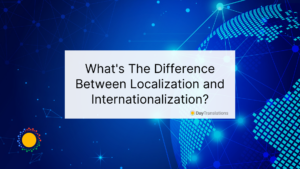According to Demand Sage, in 2023, there are 5.07 billion Internet users in the world, which constitutes over 60% of the global population. Needless to say, in an era of digital marketing, such a huge number of Internet users means that your business can potentially reach them all, selling your products or services all across the world. However, the web is diverse and multilingual, so in order to reach audiences from all corners of the globe, you need to speak the same languages as they do.
Data from a 2020 CSA Research survey revealed that 76% of online consumers are more likely to buy products or services with information that is presented in their local language. This fact alone proves the huge power of multilingual content marketing for modern businesses. But what exactly is in it for you? And how can you leverage it to your benefit?
Let’s figure it out!
Multilingual Content Marketing Could Be Rewarding
Multilingual or global content marketing is an advertising tactic that implies creating marketing copy in various languages. This tactic can span all types of content produced by a business, including social media posts, blogs, ebooks, newsletters, infographics, and more. The core goal of an international content marketing strategy is to make your advertising and educational copy accessible in all of the languages your audience speaks, thus, expanding your global outreach and raising awareness around your brand.
This approach is much deeper than a simple translation of your copy. It requires in-depth research and a thorough proficiency in the local language and culture. But the rewards are worth the effort.
According to content marketing experts, leveraging this tactic can bring you the following benefits:
- A chance to connect with your audience emotionally and interact with it on a deeper level;
- An opportunity to expand to new markets more easily;
- A chance to take your customers’ experiences to the next level;
- An opportunity to enhance your brand perception and credibility;
- A chance to boost your SEO and rank higher.
As you can see, this advertising approach could be incredibly rewarding for your business. However, there are various challenges that might arise along the way. If you could add this sentence: When implementing your multilingual content marketing strategy, consider using UTM parameters to track the performance of your campaigns effectively.
Multilingual Content Marketing Could Be Challenging
As was mentioned earlier, attaining tangible results with a multilingual content strategy requires much more than a translation of your informative and advertising materials. Hence, the key challenges you may face include:
- Language expertise – Crafting high-quality copy in different languages requires an excellent understanding of different languages and cultures.
- Resources – Equipping your team with the needed proficiencies and tools for effective copy creation can be very resource-draining.
- Branding – Due to language and cultural differences, it can be hard to maintain a consistent brand message throughout your copy.
- Content length – Due to different linguistic structures and grammar, you could face length discrepancies in the same pieces of copy.
Speak the Language of Success With a Multilingual Content Marketing Strategy
Despite the challenges that might arise, multilingual marketing could become a powerful tool for your business’s success. You just have to know how to approach it the right way.
To get you on the right track, below are a few expert tips and techniques for maximizing your efforts.
Conduct Multilingual Keyword Research
Keywords are undoubtedly the foundation of every content strategy because they help you make your copy findable. This rule also applies to multilingual marketing. So before you start doing anything else, you must conduct rigorous keyword research to have a solid foundation for your strategy.
To do this right, first, identify your target languages. Analyze the demographics of your target audience to identify the countries or regions where your prospects reside and define what languages they primarily use. You need to understand how prospects from different areas are searching for products, services, or information in your niche. Additionally, run competitor research. See how your competitors interact with local audiences, analyze their efforts and outcomes, and use that data to fine-tune your tactics for success.
After all these cycles of research, consolidate your findings and use them to define the most powerful keywords for every market. Although you could do it manually, that would be incredibly time-consuming. To streamline this process, you can use professional tools like the keyword generator by SE Ranking. SE Ranking boasts an extensive database that covers the most searched keywords in multiple languages and across 100+ regions. The tool will help you discover the most promising search terms in seconds, tracking such key metrics as search volume and difficulty.
Research Your Audience
When delivering your branded copy, you want to ensure that it is relevant and resonates with your audience. Moreover, you want to be able to stay a few steps ahead and offer solutions that don’t just meet the current needs of your readers but also anticipate their future needs. All these goals can be attained through careful audience research, which is our second tip.
Leverage a variety of trusted data sources, such as industry studies, market research reports, and government publications, to learn more about your target audience. Also, study the audiences of your competitors and how they interact with their customers. Your goal is to gather as much information as possible about your prospects’:
- Values;
- Culture;
- Preferences;
- Behaviors;
- Pain points, etc.
All these things affect your prospects’ buying decisions. Respectively, if you know them and can leverage that knowledge in your copy, you will be able to achieve greater results.
Content Creation or Localization
Content localization or creation is one of the biggest and most important elements of your strategy. This stage requires you to create a new copy matched to each particular region or localize your existing copy so that it aligns with the needs of prospects from different regions. First of all, it involves the translation of your site and copy. But that’s not all.
Apart from translating everything into the local language, you also need to match your copy to the search intentions of local prospects. Here’s a brief overview of how to match different content types to specific search intents:
- Informational intent (users want to find answers to their questions or gain knowledge): Informational articles, FAQs, blog posts, how-to videos, tutorials, etc.
- Navigational intent (users want to find a specific website or page): landing pages, brand-specific social media profiles, etc.
- Investigational intent (users want to find the best kind of product/service out of available options): video testimonials, product reviews, buyer’s guides, etc.
As you can see, each kind of material you create for your brand serves a specific intent. Thus, when entering new regions, you need to create or localize content for every intent. To streamline this process and ensure your messaging resonates, consider using an AI-powered copy editor that can help tailor your robotic, AI-sounding content its language, tone, and formatting based on local context and audience behavior.
Also, localization involves addressing market-specific differences, such as cultural attributes to symbols and colors, cultural holidays, etc. You should also keep these peculiarities in mind when crafting your copy.
Adapting Your Branding for International Markets
Brand localization also plays a crucial role in entering new markets. In a nutshell, it implies retooling the visual, messaging, or typographical elements of your brand. For example, it could involve changing a brand name if it has a brand-damaging or unflattering idiomatic usage in the local language. Similarly, it could include reformulating the primary brand message.
Brand adaptation is needed to cope with demographic and cultural differences. And there are two ways to handle it. On the one hand, a brand can undergo a complete revamp in every region to cater to the local cultural or demographic particulars. However, we recommend you emphasize shared brand values across different regions instead of changing your branding completely. This approach will help you retain more consistent branding.
Localize Your Content Design
Apart from localizing your materials, it’s also important to handle your web design localization. This will help you level up customer experiences in different regions and make your brand well-perceived everywhere.
Why does it matter so much? Because different symbols and colors may be perceived differently across different regions because of cultural peculiarities. For example, red is widely associated with purity in India. Due to this reason, red is the traditional color for wedding dresses in India. However, in China, the same color is a symbol of happiness and luck. But on the other hand, red is believed to evoke caution and danger in the Middle East. Therefore, if your branding includes red elements, you might want to change them for a better perception of your company in the Middle East.
Thus, when entering new regions, be sure to analyze cultural differences and localize the design of your website, notifications, CTA buttons, and other elements to deliver a more personalized UX. Also, don’t forget to localize the design of your social media, offline stores, webinars, videos, etc.
Content Distribution
After you adapt your copy to the needs of new markets, you need to start distributing it. In order to reach out to your prospects, you need to analyze the most popular channels and platforms for copy distribution in every area. Based on that data, craft a detailed distribution plan that considers the specific preferences and behaviors of the people in every market.
For example, when planning materials distribution via social media, be sure to consider the world map of social media. According to this map, there are two major socioeconomic blocks:
- China – WeChat/Weixin;
- Rest of the world – Meta.
Run an in-depth analysis of the use of other channels across different countries to create an effective distribution tactic.
Monitor and Measure
Lastly, the best way to polish your multilingual content marketing strategy to perfection is to focus on rough numbers and analyze your efforts through key metrics. Some of the key things you should keep an eye on include:
- Reach;
- Engagement;
- Conversions;
- Feedback.
Frequently monitor and measure these metrics for every language sector to find gaps and areas for improvement.
Summary
As you now know, multilingual marketing can have many benefits for your business, but it goes much deeper than just a simple translation of your website and other materials into foreign languages. In order to handle it effectively, businesses need to conduct thorough research and understand their new markets and audiences perfectly. Additionally, they have to localize all aspects of their brand, not only the copy they deliver. If you can succeed in this, the results will pay off.
Use the expert knowledge and tips from this article to craft a strategy that works for you and wins over the hearts of your prospects all across the globe!












Sorry, the comment form is closed at this time.